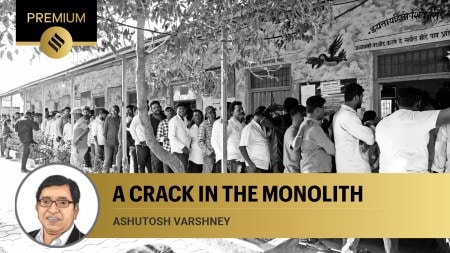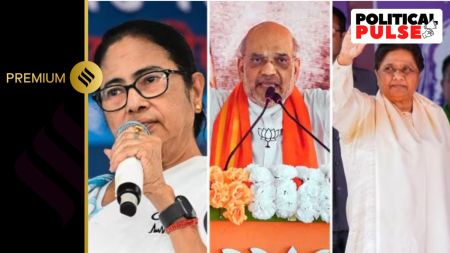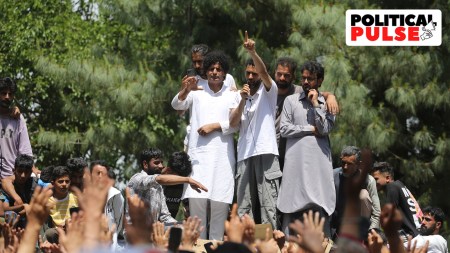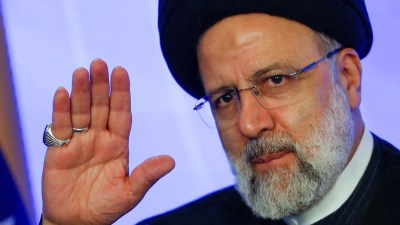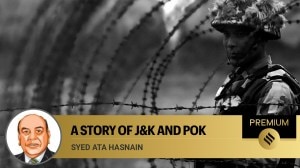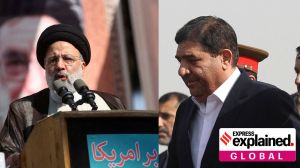- India
- International
How natural gas is central to ties between India and Qatar
In the relationship between nations, trade plays a significant role. Central to the ties between New Delhi and Doha is LNG, the fuel on which India is critically dependent — and of which Qatar is the predominant supplier. This is the context in which diplomacy around the eight Indians on death row will take place
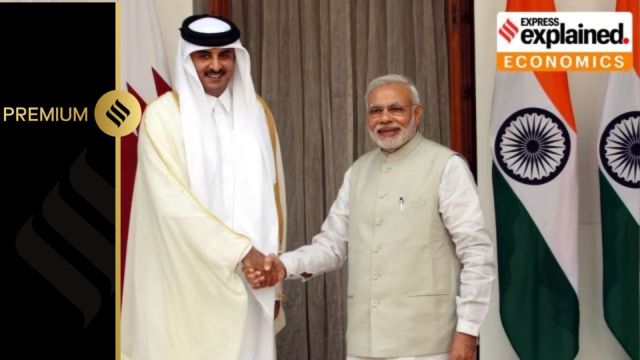 Prime Minister Narendra Modi and Emir of the State of Qatar, Sheikh Tamim Bin Hamad Al-Thani, shake hands prior to a meeting at Hyderabad House in New Delhi in March 2015. (Express photo by Prem Nath Pandey)
Prime Minister Narendra Modi and Emir of the State of Qatar, Sheikh Tamim Bin Hamad Al-Thani, shake hands prior to a meeting at Hyderabad House in New Delhi in March 2015. (Express photo by Prem Nath Pandey) The death sentence given to eight former personnel of the Indian Navy by a court in Qatar presents the biggest challenge yet to New Delhi’s historically friendly ties with Doha. In the relationship between nations, trade relations play a significant role. In the case of India and Qatar, the balance of trade is tilted heavily in the latter’s favour — which means imports from Qatar far outweigh India’s exports.
What also gives Qatar huge leverage is the nature of the trade — dominated as it is by a commodity of critical importance to India, now and for the foreseeable future. It is India’s largest source of liquefied natural gas (LNG) — gas that has been super cooled to liquid form so that it can be transported by sea — accounting for more than half of overall import volumes of the fuel. Indeed, LNG is at the heart of the trade relationship — it makes up almost 50% of overall Indian imports (by value) from Qatar.
Gas import dependency
India’s import dependency in natural gas is around 50%, and given the government’s concerted push to increase natural gas consumption, imports are only likely to rise in the coming years, even if domestic production of natural gas increases.
Government-owned Petronet LNG, India’s largest LNG importer, has a long-term contract with Qatar for the import of 8.5 million tonnes per annum (mtpa) of LNG. In addition, Qatari gas has a sizable share in India’s LNG purchases from the spot market.
India has set itself an ambitious target to increase the share of natural gas in the primary energy mix to 15% by 2030 from a little more than 6% at present. This is bound to result in a rapid increase in LNG imports over the next few years.

Natural gas is seen as a significantly cleaner alternative to conventional petroleum fuels like diesel and petrol, and is usually cheaper than crude oil. For India, which has an import dependency of over 85% in crude, gas is both more affordable and a better transition fuel in the energy transition pathway.
Given this situation with India’s energy security concerns and ambitions, the case of the retired Navy personnel presents a sensitive challenge for Indian diplomacy.
India, Qatar, and LNG
India’s total imports from Qatar in FY2022-23 were valued at $16.81 billion, of which LNG imports alone were worth $8.32 billion, or 49.5%, an analysis of official trade data shows.
India’s other major imports from Qatar are also fossil fuel-linked commodities and products, such as liquefied petroleum gas (LPG), plastics, and other petrochemicals.
On the other hand, India’s exports to Qatar were valued at just $1.97 billion in FY2022-23. The major exports include cereals, copper articles, iron and steel articles, vegetables, fruits, spices, and processed food products.
India imported a total 19.85 million tonnes of LNG in FY23, of which 10.74 million tonnes, or 54%, came from Qatar, the trade data show. This means that apart from the 8.5 million tonnes of LNG that Qatar supplied as part of the Petronet LNG term contract, nearly 2.25 million tonnes of additional gas was purchased from Qatar on spot basis last year.
While Indian LNG importers — predominantly the public sector oil and gas companies — continue to make efforts to diversify sourcing, it could be years before the high reliance on Qatar can be reduced to a meaningful extent.
The global LNG market
The global LNG market is a seller’s market after Russia’s invasion of Ukraine and the sanctions that have disrupted Russian natural gas supplies to Europe. After the war broke out, prices, particularly of LNG spot cargoes, surged globally.
Compared with term contracts (such as the one Petronet has with Qatar), the spot LNG market is prone to higher price volatility. In a supply glut, spot prices tend to fall more steeply than term contracts, as pricing in the latter is based on an agreed formula between the buyer and the seller. And when supplies are tight, spot prices tend to rise much more than term contract rates.
The war has put Qatar, the world’s largest exporter of LNG, in a unique position of strength. According to industry experts, the extreme price volatility of the past couple of years in global LNG markets has established that term contracts, and not spot purchases, are the more viable option to secure supplies at a reasonable and stable price.
This has pushed LNG importers all over the world, including India, to scout for long-term contracts with major suppliers, of whom Qatar is the foremost. Over the past few weeks, Doha has announced 27-year LNG supply deals with French, Dutch, and Italian energy majors. In the preceding months, it had signed long-term contracts to supply LNG to China and Germany.
Petronet’s term contract runs out in 2028, and negotiations for an extension are currently under way. India is also looking to sign more long-term LNG contracts.
Analysts and industry experts predict that the global LNG market is likely to turn into a buyer’s market over the next few years due to a surge in new LNG export projects coming onstream. This scenario, however, is still a few years away. And even then, a large chunk of this new LNG export capacity is expected to come onstream in Qatar itself.
More Explained
EXPRESS OPINION
May 20: Latest News
- 01
- 02
- 03
- 04
- 05



